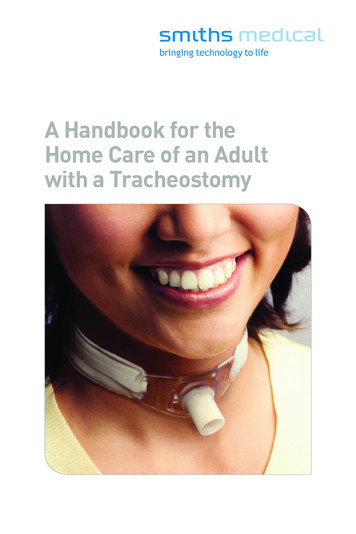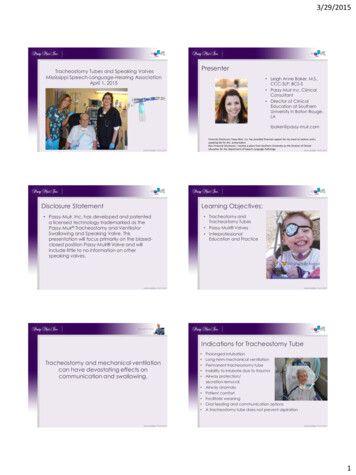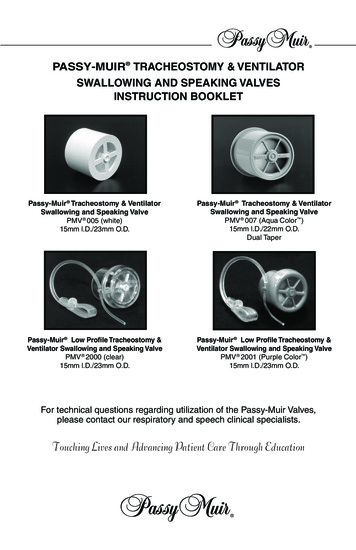
Transcription
TracheostomyEducation for Patientsand CaregiversMount SinaiDepartment of Otolaryngology—Headand Neck Surgery
Objectives1. Learn what a tracheostomy is and why it is performed2. Learn the different parts of a tracheostomy tube3. Learn how to clean and take care of a tracheostomy4. Understand how to manage common complications
Brief Introduction ToTracheostomies
What is a Tracheostomy? Opening through the neck into the trachea (windpipe)4
True or False: A tracheostomy isalways permanent Tracheostomy is only needed as long as the patientrequires it May be temporary or permanent Depends on the reason for initial tracheostomy placement5
Why would someone need atracheotomy?1.Obstruction in the mouth, larynx (voice box), orupper trachea (wind pipe)2.Prolonged intubation/Inability to be taken off theventilator3.Pulmonary Hygiene: improved cleaning of the lungs(i.e. manage secretions)6
Bypass Obstruction7
Pulmonary Hygiene Removal of secretions and protection of lungs8
Respiratory Failure/Prolonged Intubation9
Surgical Anatomy
Surgical Anatomy11
The Parts of the TracheostomyTube
Tracheostomy Components13
Tracheostomy Component Functions Outer cannula: Main portion of the tracheostomy, serves as connection between tracheaand skin Inner cannula: removable tubing that sits in the outer cannula. Allows easy removal forcleaning and care. Cuff/Balloon: required in patient requires ventilator. Ensures ventilator air goes to lungs Pilot balloon: assesses how much air is in the cuff (external) Obturator: placed in outer cannula when replacing a tracheostomy, allows easy passageinto tracheostomy stoma. Plug: In select patients, can help with speaking and eventual tracheostomy removal14
Differences in Tracheostomy Tubes Cuffed Tracheostomy Tubes:o Patients requiring a ventillatoro Cuff (balloon) blocks air from moving aroundthe tube Cuffless Tracheostomy Tubeso Patients who require a tracheostomy but don’tneed a ventilator assistanceo Without cuff, it allows air to pass around thetrachea through the voice box so that patientscan speako More comfortable15
Tracheostomy Types16
Standard Tracheostomy Care
Standard Supplies Required Tracheostomy cleaning kits Humidification and tracheostomy collar Suction set up Replacement tracheostomy tube (same size or one size smaller)18
How to Secure the Tracheostomy19
Cleaning The Tracheostomy20
Suctioning the TracheostomyWhen to Suction: As indicated by your physician andas needed Unable to cough up secretions onyour own Change in breathing or becomesharder to breath Coughing more than normal21
Tracheostomy Humidification Humidification is important: Prevents thickening of secretions and crustingMost important in first month or so after surgery Body needs to adjust to tracheostomy tubeUsually the nose and mouth humidify air, buttracheostomy bypasses these structures and allows dryair to reach lungsSeveral ways to humidify:o Trach humidification – machine with a mask placednear tracheostomyo Room humidifiero Fluid intake – important to stay hydrated22
Talking with a Tracheostomy1.Finger-Occlusion: place a finger overthe tracheostomy site and speak withfinger blocking trach hole.2.Speaking valve (Passy-Muir Valve):one way valve, which allows breathingin through the tracheostomy site andbreathing out/speaking through thevoice box23
Removal of Tracheostomy Capping trial (DO NOT TRY WITHOUT APPROVAL FROM DOCTOR):o Speak with your doctor if you feel you no longer require your tracheostomy tubeo During trial, you will test your ability to breath with the tracheostomy capped (blockingthe tracheostomy).o If able to tolerate capping for 24-48 hours without need for cap removal, then it ispossible the tracheostomy can be removed24
Management of CommonComplications
Difficulty Breathing A plug or partially plugged trach will make ithard to breatho Most often due to thickened secretions orcrusting If this happens, try to stay calm and followthese steps:oooooo Remove the inner cannulaForcefully cough several timesSuction the tracheostomyForcefully cough againSquirt saline into trachSuction and cough againIf continue to have difficulty breathing, call91126
Dislodged Tracheostomy By the time you leave the hospital, the tracheostomy stoma will bewell formed and will not close immediately You can breathe through the stoma itself and try to replace the trach.Try to replace with the following steps:oooooooo Tilt your head back slightly to make the stoma hole more openRemove the inner cannula and place the obturator inside thetracheostomy tubeApply a small amount of lubricant or saline on the tipGuide the tracheostomy tube back into the stomaHold the tracheostomy tube in placePull out the obturator, replace the inner cannulaAttach new tracheostomy tiesNote: if the tracheostomy will not go back in, try a smalltracheostomy tubeCall 911 immediately if you cannot get the tube back into place orif you are having difficulty breathing27
When to call your doctor? Bleeding from the tracheostomy Reddened or swollen skin around the stoma site More mucous than is usual, or if the mucous becomesyellow, green, or brown Foul-smelling mucous Fever of 101F or higher28
Video Demonstrations Orientation to Tracheostomy Tubes:https://www.youtube.com/watch?v UePM5wr2rH8 Tracheostomy cleaning:https://www.youtube.com/watch?v xV27o B6Is Tracheostomy suctioning, managing mucous, and changing the inner cannula:https://www.youtube.com/watch?v nob7E5WkIMI Tracheostomy Tie Replacement:https://www.youtube.com/watch?v YRPoCffgwkg29
Tracheostomy Skills Checklist30
Tracheostomy Supplies Checklist Below is a list of supplies you may need at time of discharge. Confirm with the teamthat you have all the correct supplies for discharge.31
Questions?
Tracheostomy Component Functions Outer cannula: Main portion of the tracheostomy, serves as connection between trachea and skin Inner cannula: removable tubing that sits in the outer cannula.Allows easy removal for cleaning and care. Cuff/Balloon: required in patient requires ventilator.Ensures ventilator air goes to lungs Pilot balloon: assesses how much air is in the cuff .










